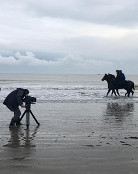Donn's Articles » Galway captivates despite quality deficiency
Galway captivates despite quality deficiency
People talk about the mystique of the Galway Festival, the magic of Galway. People say that if you could put it into bottles and present one to the IMF and the EU heads, they would stop all this talk about our corporation tax and they would order four cases of the stuff with Spanish, Portuguese, Greek and Italian labels. But then, how do you translate the magic of Galway?
If we had been around in 1869, we probably wouldn’t be scratching our heads today. 1869 was the year that Captain Wilson Lynch made a piece of land available at Ballybrit for the express purpose of racing horses. The feature race of the first meeting was to be called the Galway Plate, and it was set to be run over two and a half miles and eight obstacles, including two stone walls, for a purse of 100 sovereigns.
It is estimated that over 40,000 people descended on Galway on 16th August that year for the inaugural Galway Festival. They had to turn the park at Eyre Square into a camp site to accommodate the visitors, the Midland and Great Western Railway could not cope with the numbers of passengers who wanted to travel, and the Lough Corrib Steam Navigation Company had to put on a special service from Cong. Ironic, then, that the first Galway Plate was won by a horse named Absentee.
A century and a half on, and, in one sense, remarkably little has changed. They don’t jump them any more, but the stone walls are still there. The venue is still Ballybrit, the feature is still the Galway Plate, and the masses still descend, even if Hertz and Celtic Helicopters (the skies do not resemble the opening scene of Apocalypse Now any more, but there are still helicopters) have replaced the Great Western Railway and the Lough Corrib Steam Navigation Company.
All things being equal, it shouldn’t be thus. Galway is not like Punchestown or Leopardstown or Fairyhouse or The Curragh. You don’t have a Classic every day during the Galway Festival. Actually, you couldn’t: five Classics, seven days, there aren’t enough Classics on the racing calendar. But you don’t have a Group 1 or a Grade 1 race every day. In fact, you don’t have a Group 1 or a Grade 1 race any day. Whisper it quietly, and be prepared to be accused of heresy, but the quality of the racing isn’t actually that high.
The two feature races of the week are handicaps. Hugely lucrative handicaps, much sought-after handicaps, but handicaps nonetheless. The Tote Galway Plate on the Wednesday and the Guinness Galway Hurdle on the Thursday are surrounded by maidens and novice hurdles and novice chases and bumpers and more handicaps, which drag the week and the crowds from Monday evening to Sunday without a break these days. Even Our Lord rested on the Sabbath.
The ground staff do a fantastic job on the track every year, it can’t be easy to produce racing ground every day for seven days in a row, often without any help from the elements. It may be the height of summer, but it is Ireland, it is Galway: expect rain. Even so, it is still a tight nine-furlong round, turning, undulating track at which the draw (remember this year for the first time, low numbers good, high numbers bad) and luck-in-running are key determinants in the outcome of a race. If you are travelling from the UK to make your Galway debut this year, think more Chester than Newbury, only going the other way around. And if you are a National Hunt enthusiast, stick a couple of fences or a couple of hurdles on the track at irregular intervals, no problem.
And yet, Galway captivates. The top trainers target races there, the top owners want to have winners there, the top riders congregate there. Some top class horses have cut their teeth there, like subsequent Irish Derby winner Grey Swallow and subsequent Belmont Stakes winner Go And Go, and their trainer, Dermot Weld, has made Ballybrit his second home.
The 142-year-old success story continues unabated. On Guinness Galway Hurdle day 2006, the turnstiles clicked 48,120 times, more times than they clicked at any other Irish race meeting since the invention of turnstiles, and a shoehorn was needed to get people out after the last race. Last year, 166,067 people attended over the course of the seven days, a figure that represented an incredible 14% of the total attendance figure for all Irish racecourses for 2010.
The Galway Festival is a bit like a Sudoku puzzle – you know that all the parts join up together to make it work, you just don’t know why. The good news for John Moloney and his team is, you don’t really need to know why. You just need to keep on bottling it.
© The Racing Post, 19th July 2011


 Follow Donn
Follow Donn